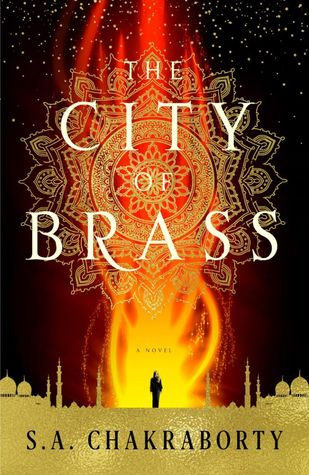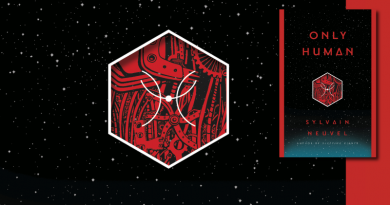Review: The City of Brass by S.A. Chakraborty
by Priya Chhaya
Is it possible to be predisposed to liking a book because of its cover? That’s how I felt before reading S.A. Chakraborty’s City of Brass, and I was thrilled when the book arrived a few days before I embarked on an eight-hour flight to Europe.
A quick synopsis: When Nahri, a young woman who spends her days as a con artist, accidentally taps into a power previously hidden, she finds that she is the only survivor of a family of magical healers known as the Nahid. After inadvertently calling a djinn warrior to her side during a faux exorcism, she is swept to Daevabad, a hidden city filled with political intrigue, magic, and clues to her own heritage and past. You can also read the summary of the novel from the publisher.
 I’ve mentioned on this blog before that I am drawn to stories with strong world-building, where the cultures our characters inhabit are built with a combination of familiarity and wonder. The world of City of Brass is one such world. In some ways it is familiar – clearly set amidst the intrigue of the Ottoman Empire – but with its own rich timeline that builds and layers through the individual histories of each character. This particular story, precipitated by Nahri’s arrival to Daevabad, is just one event in a tale that began long before we started reading. It is a culmination of a history that effects and shapes what is to come.
I’ve mentioned on this blog before that I am drawn to stories with strong world-building, where the cultures our characters inhabit are built with a combination of familiarity and wonder. The world of City of Brass is one such world. In some ways it is familiar – clearly set amidst the intrigue of the Ottoman Empire – but with its own rich timeline that builds and layers through the individual histories of each character. This particular story, precipitated by Nahri’s arrival to Daevabad, is just one event in a tale that began long before we started reading. It is a culmination of a history that effects and shapes what is to come.
The chapters flip between two perspectives – Nahri and Ali, who is Prince Alizayd al Qahtani, the younger son of the Daevabad ruler King Ghassan. Where Nahri serves as our entry into the world, learning as we do, Ali’s chapters provide us the insider perspective, of someone trying (sometimes naively) to navigate the politics of this Middle Eastern kingdom. In doing so Chakraborty provides us with two visions of Daevabad and allows us to see beyond the surface of the city’s magic.
As an overall story City of Brass moves along at a steady pace until, much like a firework after the wick is lit, it explodes into a furious, chaotically intense finale. At the end, the reader is left with the sense that we have much to learn, and much to understand, about how these events unfolded. It’s a thrilling feeling – and if you are not inclined toward binge reading, a great way of setting up anticipation for a sequel.
Two quick notes. I wouldn’t have minded one of those good old fashioned Dramatis Personae lists at the start of the book. Sometimes when there is a cast of characters that are all part of different factions, it helps to able to flip back and forth if you forget a particular relationship. Useful but not necessary.
I also would suggest that readers unfamiliar with some of the terms in the book take full advantage of the glossary at the end. While Chakraborty does a great job explaining her world, it helped to review the various breakdowns and terms as many were unfamiliar to me.
That aside, after reading City of Brass – twice – I realized why the cover, designed by Will Staehle of Unusual Corporation, drew me in so swiftly. In one glimpse, I understood what I would find on the pages within: a story of a divided city, filled with fire and magic, a beautiful city with a history that will be shaped by one woman with an extraordinary gift. I know I have a long time to wait – but I am looking forward to seeing what comes next.
City of Brass will be published on November 14, 2017.
.
The publisher provided a copy of this book for review purposes.
- Imagining a New World at FUTURES - January 10, 2022
- Escape to WandaVision - February 24, 2021
- Regency Daze and the Magic of an RPG - January 5, 2020











